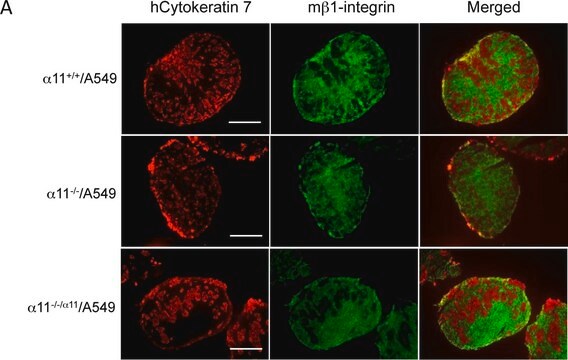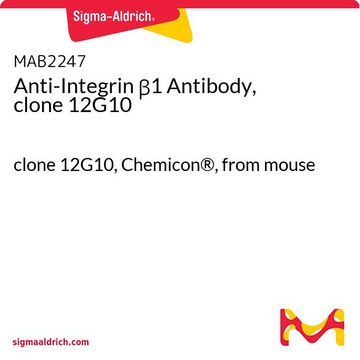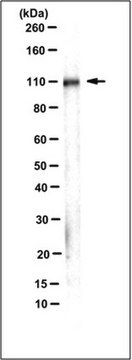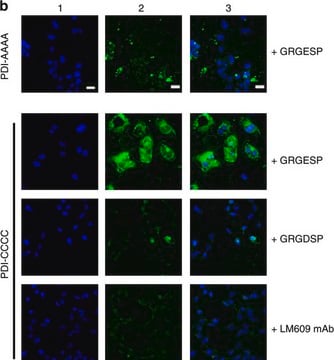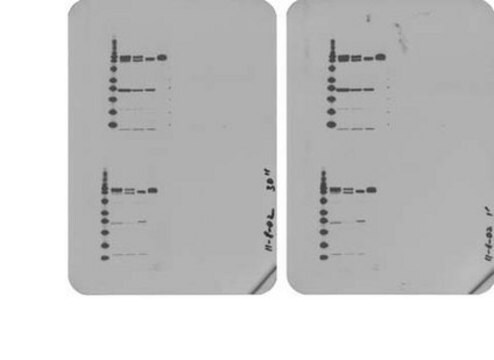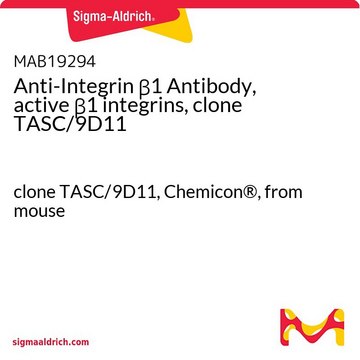MABT821
Anti-Integrin beta 1 (CD29) Antibody
rat monoclonal, mAb13
Synonim(y):
Fibronectin receptor subunit beta, Glycoprotein IIa, GPIIA, VLA-4 subunit beta, CD29
About This Item
Polecane produkty
Nazwa produktu
Anti-Integrin beta1 (CD29) Antibody, clone mAb13, clone mAb13, from rat
pochodzenie biologiczne
rat
Poziom jakości
forma przeciwciała
purified immunoglobulin
rodzaj przeciwciała
primary antibodies
klon
mAb13, monoclonal
reaktywność gatunkowa
human
opakowanie
antibody small pack of 25 μL
metody
immunohistochemistry: suitable
immunoprecipitation (IP): suitable
inhibition assay: suitable
izotyp
IgG2aκ
numer dostępu NCBI
numer dostępu UniProt
Warunki transportu
ambient
docelowa modyfikacja potranslacyjna
unmodified
informacje o genach
human ... ITGB1(3688)
Opis ogólny
Specyficzność
Immunogen
Zastosowanie
Immunocytochemistry Analysis: A representative lot detected Integrin beta1 (CD29) in Immunocytochemistry applications (Akiyama, S.K., et. al. (1989). J Cell Biol. 109(2):863-75; Humphries, J.D., et. al. (2005). J Biol Chem. 280(11):10234-43).
Immunoprecipitation Analysis: A representative lot detected Integrin beta1 (CD29) in Immunoprecipitation applications (Akiyama, S.K., et. al. (1989). J Cell Biol. 109(2):863-75).
Inhibition Analysis: A representative lot blocked HT-1080 cells adhesion to fibronectin coated plates (Courtesy of Dr. Kenneth M. Yamada, M.D., Ph.D., NIDCR, National Institutes of Health, Bethesda, MD USA).
Cell Structure
Jakość
Immunocytochemistry Analysis: A 1:500 dilution of this antibody detected Integrin beta1 (CD29) in A431 cells.
Opis wartości docelowych
Postać fizyczna
Przechowywanie i stabilność
Inne uwagi
Oświadczenie o zrzeczeniu się odpowiedzialności
Nie możesz znaleźć właściwego produktu?
Wypróbuj nasz Narzędzie selektora produktów.
Kod klasy składowania
12 - Non Combustible Liquids
Klasa zagrożenia wodnego (WGK)
WGK 2
Temperatura zapłonu (°F)
does not flash
Temperatura zapłonu (°C)
does not flash
Certyfikaty analizy (CoA)
Poszukaj Certyfikaty analizy (CoA), wpisując numer partii/serii produktów. Numery serii i partii można znaleźć na etykiecie produktu po słowach „seria” lub „partia”.
Masz już ten produkt?
Dokumenty związane z niedawno zakupionymi produktami zostały zamieszczone w Bibliotece dokumentów.
Nasz zespół naukowców ma doświadczenie we wszystkich obszarach badań, w tym w naukach przyrodniczych, materiałoznawstwie, syntezie chemicznej, chromatografii, analityce i wielu innych dziedzinach.
Skontaktuj się z zespołem ds. pomocy technicznej